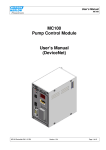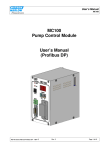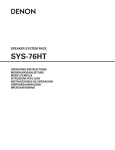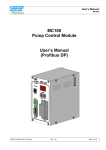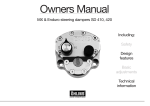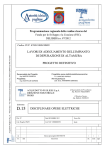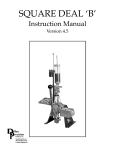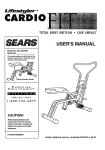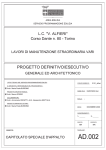Download Yamaha WR450F(W) Service manual
Transcript
SUPPLEMENTARY OWNER’S SERVICE MANUAL WR450F(S) 2-TRAC 5TJ-F8199-E0 WR450F(S) 2-TRAC SUPPLEMENTARY OWNER’S SERVICE MANUAL © 2004 by Yamaha Motor Italia S.p.A. First edition, March 2004 All rights reserved. Any reproduction or unauthorized use without the written permission of Yamaha Motor Italia S.p.A. is expressly prohibited. Printed in Italy CONTENTS HYDROSTATIC TRANSMISSION .......................................................................................... WHEN DRIVING .............................................................................................................. FUNCTION ...................................................................................................................... ADJUSTMENTS .............................................................................................................. ALTERNATE RATIOS (OPTIONS) .................................................................................. TOOLS ............................................................................................................................ 2 2 2 3 3 3 SPECIAL TOOLS .................................................................................................................. 4 SPECIFICATIONS .................................................................................................................. 6 GENERAL SPECIFICATIONS ........................................................................................ 6 MAINTENANCE SPECIFICATIONS ...................................................................................... CHASSIS ........................................................................................................................ TIGHTENING TORQUES ................................................................................................ CABLE ROUTING DIAGRAM .......................................................................................... 7 7 8 9 REGULAR INSPECTION AND ADJUSTMENTS..................................................................17 MAINTENANCE INTERVALS ........................................................................................ 17 SUPPLEMENTARY INSPECTION AND ADJUSTMENTS ............................................ 17 HYDROSTATIC TRANSMISSION.................................................................................. 17 STEERING DAMPER ADJUSTMENT .......................................................................... 18 FRONT FORK REBOUND DAMPING FORCE ADJUSTMENT .................................... 21 FRONT FORK COMPRESSION DAMPING FORCE ADJUSTMENT .......................... 22 REAR SHOCK ABSORBER SPRING PRELOAD ADJUSTMENT ................................ 23 REAR SHOCK ABSORBER REBOUND DAMPING FORCE ADJUSTMENT .............. 24 REAR SHOCK ABSORBER LOW COMPRESSION DAMPING FORCE ADJUSTMENT .............................................................................................................. 25 REAR SHOCK ABSORBER HIGH COMPRESSION DAMPING FORCE ADJUSTMENT .............................................................................................................. 26 CARBURETOR DISASSEMBLY .......................................................................................... 27 TRANSMISSION .................................................................................................................. 28 DRIVE UNIT – TRANSMISSION ASSY ........................................................................ 28 HYDROSTATIC TRANSMISSION.................................................................................. 30 INSPECTION ................................................................................................................ 30 CHANGE OIL IN THE HYDRAULIC MOTOR REDUCTION GEAR HOUSING ............ 30 CHANGE OIL IN THE PUMP TRANSMISSION HOUSING .......................................... 31 CHECK THE WEAR IN THE PUMP TRANSMISSION.................................................. 32 CHANGING THE RATIOS FOR THE PUMP TRANSMISSION .................................... 33 FRONT WHEEL .................................................................................................................... 35 FRONT WHEEL REMOVAL .......................................................................................... 35 FRONT FORK ...................................................................................................................... FRONT FORK DISASSEMBLY...................................................................................... FRONT FORK SPECIFICATION CARD – ÖHLINS® .................................................... OIL LEVEL ADJUSTMENT ............................................................................................ CHANGING SPRINGS .................................................................................................. DISMANTLING .............................................................................................................. ASSEMBLING ................................................................................................................ 36 36 38 39 40 42 45 REAR SHOCK ABSORBER ................................................................................................ 48 REAR SHOCK ABSORBER DISASSEMBLY ................................................................ 48 INSPECTION AND MAINTENANCE.............................................................................. 49 STEERING DAMPER .......................................................................................................... 50 DISASSEMBLY AND INSPECTION .............................................................................. 51 1 HYDROSTATIC TRANSMISSION WHEN DRIVING Driving a two wheel driven motorcycle is different from driving a conventional motorcycle. The front wheel drive system, during certain conditions, affects the feeling of the handlebar. In sand, mud and snow the traction is greatly improved. However in conditions with deep ruts and slippery surfaces the two wheel drive system might contribute to that the motorcycle feels heavier and more brutal. WARNING It is of absolute necessity that the two wheel drive motorcycle has a steering damper. If driven without steering damper the front wheel, when hitting a root or a stone, can give unduly high reaction forces to the handlebar. Before racing, practise as much as possible on different tracks and under different conditions to get used to the different behaviour of the two wheel drive system. CAUTION: On rough road surfaces the front wheel drive can make the steering harder. This is noticeable, especially when driving aggressively. When landing after jumps the two wheel drive system will make the front fork feel stiffer due to that the driving force tries to extend the front fork, especially if the throttle is applied before touchdown. NOTE: This 2-Trac system has been tested extensively on both test tracks and in races. Imperative for the durability and function is high quality material in all components. The high quality materials used are not always the best suited to provide beautiful surface treatment. As a result we can sometimes see shades and/or mis-colouring on the anodised aluminium surfaces. FUNCTION With the motorcycle free rolling, the pump rotates roughly with the same speed as the motor. When throttle is applied the rear wheel and thereby the pump, due to deformation of the rear tire, starts to rotate a little bit faster even if the driving force is just large enough to maintain constant speed. The increased volume stream from the pump causes the speed of the motor to increase, but to a lesser extent than the pump, thereby creating a driving torque from the front wheel. Thus the amount of front wheel driving force varies with speed and ground condition and comes in gradually depending on throttle position. The system has a maximum pressure relieve valve installed to prevent dangerously high pressure in the system, when for instance on slippery surfaces, where excessive rear wheel spin can occur. The oil in the transmission can sometimes get very hot. For instance in sandy, slow speed conditions or when trying to escape from a mud pit. In order to prevent damage to the transmission a built in thermostat valve shortcuts the hydraulic circuit, thereby disconnecting the front wheel drive. When this occur a couple of minutes cooling time is needed to get the system back into function again. 2 ADJUSTMENTS The pulling force, at a given circumstance, can be varied by changing the rear wheel sprocket up or down one tooth. If we increase the no by one tooth the pump rotates faster in relation to the hydraulic motor, thereby increasing the pressure in the system and increasing the pulling force of the front wheel. It must be understood that even the reaction forces in the handlebar increases. From experience the gain is negligible. When decreasing with one/two/three teeth the pulling force is reduced. The advantage is that the steering feels lighter and, on most ground conditions, there is no increased lap times, but can be preferable during long endurance races. WARNING Changing the number of teeth of the sprockets more than one tooth up causes unduly high reaction forces in the handlebar. It can also give permanent damages to the hydraulic transmission because of raised oil temperature in the transmission and increased wear. Changing the number of teeth in the pump transmission without changing the rear-wheel ratio also can cause permanent damage to the hydraulic transmission. ALTERNATE RATIOS (OPTIONS) There are alternate ratios for the pump transmission. Alternate ratios kit Pump transmission ratio Rear wheel ratio GTYA E00 15/22 standard 14/50 GTYA E01 12/20 P-D 15/47 The kit contains: – Chain-sprocket pump – Chain-wheel pump – Chain – Chain guide – Collar – Screw chain-sprocket NOTE: More ratios will be available later. TOOLS A specially designed puller tool is demanded to remove the pump sprocket. Refer to “SPECIAL TOOLS”. 3 SPECIAL TOOLS GEN INFO SPECIAL TOOLS The following special tools are necessary for complete and accurate tune-up and assembly. Use only the appropriate special tools; this will help prevent damage caused by the use of inappropriate tools or improvised techniques. Special tools may differ by shape and part number from country to country. In such a case, two types are provided. When placing an order, refer to the list provided below to avoid any mistakes. Tool name/How to use Tool No. Puller 90890-XXXXX (1874-01) Use this tool to remove the pump sprocket (hydraulic transmission). Bushing remover 90890-XXXXX (1702-02) Use this tool to remove the front forks bushing. Tool cartridge top cap 90890-XXXXX (1797-01) Use this tool to remove and install the front forks damper rod. Mounting sleeve 90890-XXXXX (1799-02) Use this tool to install the front forks bushing and seals. Tool compression adjuster (Bob) 90890-XXXXX (1860-01) Use this tool to unscrew and screw the front forks top cap. Mandrel ball joints (26 mm) 90890-XXXXX (0721-01) This tool is needed to remove and install the ball joints. Sleeve (26 mm) 90890-XXXXX (0723-01) This tool is needed to remove and install the ball joints with the mandrel. 4 Illustration SPECIAL TOOLS Tool name/How to use Tool No. Soft jaws 90890-XXXXX (0727-03) Use this tool for piston shafts 14-16 mm. Steering damper holder 90890-XXXXX (04957-01) Use this tool for holding the steering damper unit with or without link arm. Puller 90890-XXXXX (04954-01) Use this tool for demounting the steering damper linkarm. 90890-XXXXX (04955-01) Sockets 90890-XXXXX (04956-01) Use this tools for mounting the steering damper linkarm. Mandrel 90890-XXXXX (04951-01) Use this tool to install the steering damper X-ring seal. Holder 90890-XXXXX (04960-01) This tool is used for gripping the steering damper high speed adjuster. 5 GEN INFO Illustration GENERAL SPECIFICATIONS SPEC SPECIFICATIONS GENERAL SPECIFICATIONS Item Standard Model name: WR450F ’04 – 2-TRAC (EUROPE) Model code number: 5TJ6 (EUROPE) Dimensions: Overall length Overall width Overall height Seat height Wheelbase Minimum ground clearance 2,171 mm (85.5 in) 827 mm (32.6 in) 1,303 mm (51.3 in) 998 mm (39.3 in) 1,485 mm (58.5 in) 371 mm (14.6 in) Dry weight: Without oil and fuel 128.0 kg (282 lb) Tire: Type Size (front) Size (rear) Tire pressure (front) With tube 90/90-21 54R (EUROPE, AUS, NZ) 130/90-18 69R (EUROPE, AUS, NZ) 100~120 kpa (1.0~1.2 kgf/cm2, 15~17 psi) (depending on the track condition) 100 kPa (1.0 kgf/cm2, 15 psi) Tire pressure (rear) Suspension: Front suspension Rear suspension Telescopic fork Swingarm (link type monocross suspension) Shock absorber: Front shock absorber Rear shock absorber Coil spring/oil damper Coil spring/gas, oil damper Wheel travel: Front wheel travel Rear wheel travel 300 mm (11.8 in) 315 mm (12.4 in) Hydrostatic transmission: Pump/Motor: Displacement of pump/motor Max speed Max torque Max pressure Typical pressure Transmission: Transmitted power, maximum Weight Efficiency Oil volume Ratio hydraulic motor/front wheel Torque distribution 5 cm3 per revolution 8,000 rpm 25 Nm 320 bar 50-200 bar 21 kW 6.7 kg 92 % 0.6 L 5.36 : 1 0-15 % on front wheel – depending on ground condition and throttle position 382 N Max pulling force on front wheel Oil capacity: Pump transmission housing Hydraulic motor reduction gear housing Oil type: Pump transmission housing Hydraulic motor reduction gear housing 0.07-0.08 L 0.075 L Castrol SLX030 Castrol SLX030 6 MAINTENANCE SPECIFICATIONS SPEC MAINTENANCE SPECIFICATIONS CHASSIS Item Standard Limit Front suspension: Shock absorber travel Fork spring free length Installed length Collar length Spring rate (K1) Spring rate (K2) Spring stroke (K1) Spring stroke (K2) Optional spring available Quantity Level Recommended oil Inner tube outer diameter 300 mm ••• 467 mm 460 mm 463 mm (4 mm preload) ••• – ••• 4.5 N/mm (Left leg), 4.1 N/mm (Right leg) ••• 10 N/mm (Top out spring) ••• 300 mm ••• 25 mm (approximately) ••• Yes ••• 2 625 cm (approximately) ••• 105 mm ••• Öhlins part no: 1305-01 (SAE 5W) ••• 46 mm ••• Rear suspension: Rear shock absorber assembly travel Rear wheel travel Spring free length Installed length Spring rate (K1) Spring stroke (K1) Optional spring available Enclosed gas/air pressure (STD) Recommended oil 132 mm 315 mm 270 mm 251.5 mm (18.5 mm preload) 52 N/mm 0~132 mm Yes 10 bar Öhlins part no: 1306-01 7 ••• ••• ••• ± 5 mm ••• ••• ••• ••• ••• MAINTENANCE SPECIFICATIONS SPEC TIGHTENING TORQUES Thread size Part to be tightened Tightening torque N·m Remarks m·kg Carburetor drain plug screw Engine guards (3, 4) and frame Frame and rear frame (upper) Frame and rear frame (under) Muffler (rear) and frame Muffler (middle) and frame Muffler band/exhaust pipe Nut pivot shaft and frame Screw and nut pivot shaft Rear shock absorber upper and frame Rear shock absorber (lower) and arm relay Front fork handle crown and inner tube Front fork under bracket and inner tube Bracket meter bolt and handle crown Protector guide compl. screw and outer tube Front fork protector bolt and bottom front fork Pitch bolt and bottom front fork Front fork protector screw (upper) and front fork protector Front fork protector screw (middle) and front fork protector Front fork protector screw (lower) and front fork protector M6 x 0.75 M8 x 1.25 M8 x 1.25 M8 x 1.25 M8 x 1.25 M8 x 1.25 M8 x 1.25 M16 x 1.5 M6 x 1.0 M10 x 1.25 M10 x 1.25 M8 x 1.25 M8 x 1.25 M6 x 1.0 M5 x 0.8 M6 x 1.0 M8 x 1.25 2.5 23 32 29 35 35 16 88 14 55 55 20 12 7 2 max 10 20 0.25 2.3 3.2 2.9 3.5 3.5 1.6 8.8 Add Loctite® 243 1.4 Add Loctite® 243 5.5 5.5 2.0 1.2 0.7 0.2 max 1.0 2.0 M5 x 0.8 2 max 0.2 max Add Loctite® 243 M5 x 0.8 2 max 0.2 max Add Loctite® 243 M5 x 0.8 2 max Front fender and under bracket Side covers (lower) and frame Side covers (front) and panel radiator (lower) Side covers (front) and fuel tank/radiator Single seat assy and frame Upper handle holder and handle crown Steering damper assy and upper handle holder Bracket steering 1 (steering damper system) and bracket steering 2 M6 x 1.0 M6 x 1.0 M6 x 1.0 M6 x 1.0 M8 x 1.25 M8 x 1.25 M6 x 1.0 7 7 6 6 23 28 12 0.2 max Add Loctite® 243 on the screw/spacer 0.7 0.7 0.6 0.6 2.3 2.8 1.2 Add Loctite® 542 M5 x 0.8 7 Front wheel shaft and front fork Front caliper and front fork Clamp hose brake and front fork Cover hose brake and nut axle front Cover hose brake and front fork Screw throttle grip Master cylinder and handlebar Body cowling (upper) and stay 1/bracket main switch Headlight (lower) and headlight stay 2 Switches handle and handlebar Clutch holder lever Bracket 1 (hydraulic drive unit assy) and fuel tank damper holder Bracket 2 (hydraulic drive unit assy) and cylinder Hydraulic drive unit assy and engine crankcase (LH) M16 x 1.5 M8 x 1.25 M6 x 1.0 M8 x 1.25 M6 x 1.0 M5 x 0.8 M6 x 1.0 M6 x 1.0 M6 x 1.0 M3 x 0.5 M5 x 0.8 M6 x 1.0 M6 x 1.0 M6 x 1.0 8 0.7 Add Loctite® 542 L=12 mm, L=16 mm 105 10.5 23 2.3 10 1.0 16 1.6 7 0.7 4 0.4 9 0.9 10 1.0 7 0.7 0.6 max 0.06 max 4 0.4 10 10 10 1.0 1.0 1.0 Add Loctite® 243 CABLE ROUTING DIAGRAM SPEC CABLE ROUTING DIAGRAM 1 2 3 4 5 6 7 8 9 0 q w e r t Fuel tank breather hose Clamp Diode Wire harness Hot starter cable Negative battery lead Starter motor lead TPS (throttle position sensor) lead Neutral switch lead Oil hose Hose holder Radiator hose 4 Cylinder head breather hose AC magneto lead Radiator hose 1 y u i o t a Oil tank breather hose Brake hose Hose guide Carburetor breather hose Overflow hose Coolant reservoir tank breather å Insert the fuel tank breather hose into the hole in the steering shaft cap. ∫ Fasten the diode of the wire harness and rectifier/regulator lead (at its protecting tube) to the frame at the white tape for the diode with a plastic locking tie and cut off the tie end. 9 ç Fasten the wire harness, rectifier/regulator lead, coolant reservoir hose and hot starter cable to the frame with a plastic locking tie and cut off the tie end. ∂ Fasten the wire harness, rectifier/regulator lead and coolant reservoir hose to the frame with a plastic locking tie and cut off the tie end. ´ Fasten the wire harness to the frame at its white tape with a plastic locking tie and cut off the tie end. CABLE ROUTING DIAGRAM ƒ Fasten the wire harness, TPS lead (in the wire harness), starter motor lead and negative battery lead to the frame with a plastic locking tie and cut off the tie end. © Make sure that the TPS coupler does not go out the chassis. ˙ Fasten the TPS lead to the frame with a plastic band. ˆ Fasten the neutral switch lead and oil hose together with the plastic locking ties and cut off the tie ends. ∆ Pass the cylinder head breather hose through the hose holders. SPEC ˚ Fasten the neutral switch lead to the frame with a plastic band ends outward. ø Pass the wire harness on the outside of the neutral switch lead and AC magneto lead. ¬ Fasten the neutral switch lead and AC magneto lead to the frame with a plastic band ends outward. π Fit the brake hose into the guides on the protector. µ Pass the cylinder head breather hose on the outside of the radiator hose 1 and on the inside of the radiator pipe (radiator hose 4). ˜ Pass the oil tank breather hose on the outside of the AC magneto lead, neutral switch lead, wire harness and cylinder head breather hose. 10 œ Pass the wire harness through the cable guide. ® Fasten the AC magneto lead and neutral switch lead to the cable guide at their protecting tube with a plastic locking tie and cut off the tie end. ß Pass the carburetor breather hoses, overflow hose and coolant reservoir tank breather hose so that the hoses do not contact the rear shock absorber. CABLE ROUTING DIAGRAM 1 Drive chain housing 2 3 4 5 6 7 8 (transmission assy) Pump (transmission assy) Hose (pump/reservoir) Reservoir (transmission assy) Hose (motor/pump) Bracket (reservoir) Clamp Motor (transmission assy) 11 SPEC CABLE ROUTING DIAGRAM 1 2 3 4 5 6 7 8 Hot starter cable Clutch cable Throttle cable (return) Throttle cable (pull) Ignition coil Negative battery lead Starter motor lead Coolant reservoir tank breather hose 9 Rectifier/regulator 0 Cable holder q w e r t y u i o p Coolant reservoir hose Rectifier/regulator lead Clamp CDI unit lead CDI unit CDI unit band CDI unit stay (frame) Cable bracket Clamp (transmission hoses) Transmission motor 12 SPEC å Pass the throttle cables, clutch cable and hot starter cable through the cable guides. ∫ Pass the throttle cables, clutch cable and hot starter cable between the radiator and frame, then over the middle radiator mounting boss. ç Pass the throttle cables and clutch cable on the outside of the ignition coil. CABLE ROUTING DIAGRAM ∂ Pass the carburetor breather hose (throttle cable cover) through the hose holder. ´ Fasten the coolant reservoir tank breather hose and carburetor breather hoses together with a plastic locking tie. ƒ Fasten the grommet of the clutch cable with the cable holder. © Fasten the rectifier/regulator lead to the frame with a plastic locking tie and cut off the tie end. ˙ Fasten the CDI unit lead to the frame with a plastic locking tie ends at the lower of the frame and cut off the tie end. ˆ Insert the CDI unit band over the CDI unit stay (frame) as far as possible. 13 SPEC ∆ Fasten the starter motor lead and negative battery lead to the cable bracket in its slot with a plastic locking tie and cut off the tie end. ˚ Do not allow the rectifier/regulator lead to slacken. ¬ Fasten the clamp so that the point of closing is found inside the protection of transmission hoses. CABLE ROUTING DIAGRAM 1 Master cylinder 2 Brake hose holder 3 Brake hose å Install the brake hose so that its pipe portion directs as shown and lightly touches the projection on the caliper. ∫ Pass the brake hose into the brake hose holders. 14 SPEC ç If the brake hose contacts the spring (rear shock absorber), correct its twist. ∂ Install the brake hose so that its pipe portion directs as shown and lightly touches the projection on the master cylinder. CABLE ROUTING DIAGRAM 1 2 3 4 5 6 7 8 9 0 Starter motor lead Negative battery lead Wire harness Clamp Taillight lead Coolant reservoir tank breather hose Coolant reservoir hose Positive battery lead Starting circuit cut-off relay Battery å Position the starter motor lead, negative battery lead and wire harness in the tank damper slit. ∫ Fasten the wire harness to the frame with a plastic locking tie and cut off the tie end. ç Do not allow the taillight lead to slacken. ∂ Pass the starter motor lead and negative battery lead over the carburetor. 15 SPEC ´ Fasten the coolant reservoir tank breather hose and coolant reservoir hose to the frame with a plastic band. ƒ Pass the coolant reservoir hose on the outside of the coolant reservoir tank breather hose. CABLE ROUTING DIAGRAM 1 2 3 4 5 6 7 8 9 0 q w e r Throttle cable Clamp Brake hose Hot starter cable Clutch cable Hose guide Clutch switch lead "ENGINE STOP" button lead Trip meter cable Main switch lead Steering damper cover Main switch Start switch lead Clamp (steering damper cover) å Fasten the start switch lead to the handlebar with the plastic bands. ∫ Fasten the "ENGINE STOP" button lead and clutch switch lead to the handlebar with the plastic bands. ç Pass the brake hose through the hose guides. 16 SPEC ∂ Pass the start switch lead in front of the main switch lead. ´ Pass the hot starter cable between the handle crown and coupler bracket. ƒ Pass the throttle cables and clutch cable between the handle crown and trip meter. MAINTENANCE INTERVALS INSP ADJ REGULAR INSPECTION AND ADJUSTMENTS MAINTENANCE INTERVALS The following schedule is intended as a general guide to maintenance and lubrication. Bear in mind that such factors as weather, terrain, geographical location, and individual usage will alter the required maintenance and lubrication intervals. If you are a doubt as to what intervals to follow in maintaining and lubricating your machine, consult your Yamaha dealer. SUPPLEMENTARY INSPECTION AND ADJUSTMENTS After break-in Every race FRONT FORKS Inspect and adjust Replace oil Replace oil seal •• • FRONT FORKS OIL SEAL AND DUST SEAL Clean and lube • • • • • • Item REAR SHOCK ABSORBER Inspect and adjust Lube Retighten STEERING DAMPER Replace oil Every Every As third (or fifth (or required 500 km) 1,000 km) • • Remarks Öhlins oil No. 5 (1305-01) Öhlins red grease (146-01) • In new dampers after 10 hours riding and then every 20 hours riding (After rain ride) • Molybdenum disulfide grease Öhlins oil (1306-01) HYDROSTATIC TRANSMISSION Check the condition of the hoses. It is of vital importance that there is no damage on the hoses, especially important is the reinforcement mesh: no damaged cord is allowed. Check for oil leaks (sweating) of all connections. Every 5th hour check the status of the system. By use of the control button, under the reservoir, the normal position is out. If it is pressed in and doesn’t come out again there can be two causes. Either the charge pressure has dropped or oil has leaked out. In both cases bring the motorcycle to a Yamaha Service Centre. If the button hasn’t been tested for a longer period it can be a little sticky, if so pull it in and out a couple of times to lubricate the seal, then press it in again to make the function check. Service Every 20th hour: – Change oil in the hydraulic motor reduction gear housing – Change oil in the pump transmission housing – Check the wear in the pump transmission. The oil in the reduction gear housing is changed by taking the hydraulic motor from the shield. The oil in the pump transmission is drained by taking off the lid. There is a filler plug on top of the transmission housing. WARNING It is connected with danger to open the hydraulic transmission. That includes the plugs on the Pump/Motor housing as well. The transmission comes filled and pressurized from the manufacturer. 17 STEERING DAMPER ADJUSTMENT INSP ADJ STEERING DAMPER ADJUSTMENT The steering damper is a hydraulic damper that counteracts wobble, alleviates shock against the front wheel and prevents head shake/cast by the motorcycle, which gives safer riding. The damper is fitted on the upper fork crown, in the centre over the steering stem 1. When turning, and in the event of wobbling, shock, etc, the link arm of the damper is twisted, thus forcing fluid through three independently acting valve systems in the damper cover. Setting The steering damper has three external setting possibilities, i.e., setting of the damper valve, highspeed valve and sweep valve, which regulate the damping area 2. Low speed valve The steering damper is delivered with the low speed valve set in a basic position that gives maximum basic damping. For enduro and motocross it is suitable to set the low speed in position 4-8, depending on the track and the rider. Turn clockwise to increase damping and counter clockwise to reduce it 3. High speed valve The high-speed valve 4 is set between 11/4 to 2 turns from the bottom position, suitable for enduro, motocross and off-road. For all riding, the highspeed valve must be set screwed up at least 1 turn from the bottom. 18 STEERING DAMPER ADJUSTMENT INSP ADJ Damping sweep controls Damping sweep controls 5 are located on each side off the damper body. Damping is in position 2, (12 o´clock), when delivered from Yamaha. This setting is fitted for enduro, motocross and off-road riding. WARNING Always ensure that valve setting is within the permitted ranges. NOTE: Both damping sweep controls must always be set in identical positions. Always use positions according to the clock. Suitable starting position: Motocross pos. 1 or 2 Enduro pos. 2 or 3 Off-Road pos. 2, 3 or 4 Technical data External measures Seals Oil 70x70x35 mm Low friction type Öhlins part no. 01306-01 Maintenance and inspection The steering damper is a precision instrument, with extremely fine tolerances. It is therefore essential that it is maintained in a correct manner. Maintenance and service should be carried out by an authorised service center. NOTE: After washing the motorcycle wipe clean and spray with all-round oil. CAUTION: Never subject to direct high-pressure cleaning since water may otherwise penetrate the damper. CAUTION: Ensure that there is no leakage of fluid and that there is no visible damage to the housing and mounts. 19 STEERING DAMPER ADJUSTMENT INSP ADJ Change the fluid regularly. In new dampers after 10 hours riding and then every 20 hours riding. Use only recommended fluid that is tested and approved by Yamaha. We cannot guarantee fully acceptable operation using other fluids. NOTE: Regular maintenance and inspection counteracts possible malfunction. If the steering damper needs service, Öhlins agents have the proper tools and know-how to solve all technical problems. NOTE: Discarded products should be handled over to an authorized work shop or distributor for proper disposal. Trouble Shooting Little or no damping 1 Debris in valving or worn parts internally, need service. 2 Shear pin on bottom has broken due to a crash or over stressing. This can be replaced easily by removing the link-arm with a link-arm puller and installing a new shear pin. Dampens more to one side than the other 1 It´s new, give it a little time to seat the valving. 2 The oil is dirty and it need servicing. Knob has come off 1 Don’t panic, it will still work. To repair it, remove the set screw, put the knob back on and allow it to seat over the o-ring. Reinsert the steel ball, then the spring and finally the set screw until flush with the top of the knob. 20 FRONT FORK REBOUND DAMPING FORCE ADJUSTMENT INSP ADJ FRONT FORK REBOUND DAMPING FORCE ADJUSTMENT The rebound adjuster is located at the top of the fork leg. 1. Adjust: • Rebound damping force By turning the adjuster. Stiffer → Increase the rebound damping force. (Turn the adjuster in.) Softer → Decrease the rebound damping force. (Turn the adjuster out.) Extent of adjustment: Maximum Fully turned in position Minimum 20 clicks out (from maximum position) • STANDARD POSITION This is the position which is back by the specific number of clicks from the fully turned-in position. Standard position: 14 clicks out CAUTION: Do not force the adjuster past the minimum or maximum extent of adjustment. The adjuster may be damaged. WARNING Always adjust each front fork to the same setting. Uneven adjustment can cause poor handling and loss of stability. 21 FRONT FORK COMPRESSION DAMPING FORCE ADJUSTMENT INSP ADJ FRONT FORK COMPRESSION DAMPING FORCE ADJUSTMENT The compression adjuster is located at the bottom of the fork leg. 1. Adjust: • Compression damping force By turning the adjuster. Stiffer → Increase the compression damping force. (Turn the adjuster in.) Softer → Decrease the compression damping force. (Turn the adjuster out.) Extent of adjustment: Maximum Fully turned in position Minimum 20 clicks out (from maximum position) • STANDARD POSITION This is the position which is back by the specific number of clicks from the fully turned-in position. Standard position: 16 clicks out CAUTION: Do not force the adjuster past the minimum or maximum extent of adjustment. The adjuster may be damaged. WARNING Always adjust each front fork to the same setting. Uneven adjustment can cause poor handling and loss of stability. 22 REAR SHOCK ABSORBER SPRING PRELOAD ADJUSTMENT INSP ADJ 1 REAR SHOCK ABSORBER SPRING PRELOAD ADJUSTMENT 2 1. Elevate the rear wheel by placing the suitable stand under the engine. 2. Remove: • Rear frame 3. Loosen: • Locknut 1 4. Adjust: • Spring preload By turning the adjuster 2. Stiffer → Increase the spring preload. (Turn the adjuster 2 in.) Softer → Decrease the spring preload. (Turn the adjuster 2 out.) Spring length (installed): Standard length Extent of adjustment 251.5 mm 246.5~256.5 mm NOTE: • Be sure to remove all dirt and mud from around the locknut and adjuster before adjustment. • The lenght of the spring (installed) changes 1.5 mm (0.06 in) per turn of the adjuster. CAUTION: Never attempt to turn the adjuster beyond the maximum or minimium setting. 5. Tighten: • Locknut 6. Install: • Rear frame (upper) 32 Nm (3.2 m•kg, 23 ft•lb) • Rear frame (lower) 29 Nm (2.9 m•kg, 21 ft•lb) 23 REAR SHOCK ABSORBER REBOUND DAMPING FORCE ADJUSTMENT INSP ADJ REAR SHOCK ABSORBER REBOUND DAMPING FORCE ADJUSTMENT b 1. Adjust: • Rebound damping force By turning the adjuster 1. a Stiffer a → Increase the rebound damping force. Softer b → Decrease the rebound damping force. Extent of adjustment: Maximum Fully turned in position Minimum 40 clicks out (from maximum position) • STANDARD POSITION This is the position which is back by the specific number of clicks from the fully turned-in position. Standard position: About 24 clicks out Adjustment range: ± 5 clicks CAUTION: Do not force the adjuster past the minimum or maximum extent of adjustment. The adjuster may be damaged. 24 REAR SHOCK ABSORBER LOW COMPRESSION DAMPING FORCE ADJUSTMENT INSP ADJ REAR SHOCK ABSORBER LOW COMPRESSION DAMPING FORCE ADJUSTMENT 1. Adjust: • Low compression damping force By turning the adjuster 1. Stiffer a → Increase the low compression damping force. (Turn the adjuster 1 in.) Softer b → Decrease the low compression damping force. (Turn the adjuster 1 out.) Extent of adjustment: Maximum Fully turned in position Minimum 25 clicks out (from maximum position) • STANDARD POSITION This is the position which is back by the specific number of clicks from the fully turned-in position. Standard position: About 15 clicks out Adjustment range: ± 5 clicks CAUTION: Do not force the adjuster past the minimum or maximum extent of adjustment. The adjuster may be damaged. 25 REAR SHOCK ABSORBER HIGH COMPRESSION DAMPING FORCE ADJUSTMENT INSP ADJ REAR SHOCK ABSORBER HIGH COMPRESSION DAMPING FORCE ADJUSTMENT 1. Adjust: • High compression damping force By turning the adjuster 1. Stiffer a → Increase the high compression damping force. (Turn the adjuster 1 in.) Softer b → Decrease the high compression damping force. (Turn the adjuster 1 out.) Extent of adjustment: Maximum Fully turned in position Minimum 4 clicks out (from maximum position) • STANDARD POSITION This is the position which is back by the specific number of turns from the fully turned-in position. Standard position: About 2.5 turns out Adjustment range: ± 1 turn CAUTION: Do not force the adjuster past the minimum or maximum extent of adjustment. The adjuster may be damaged. 26




























